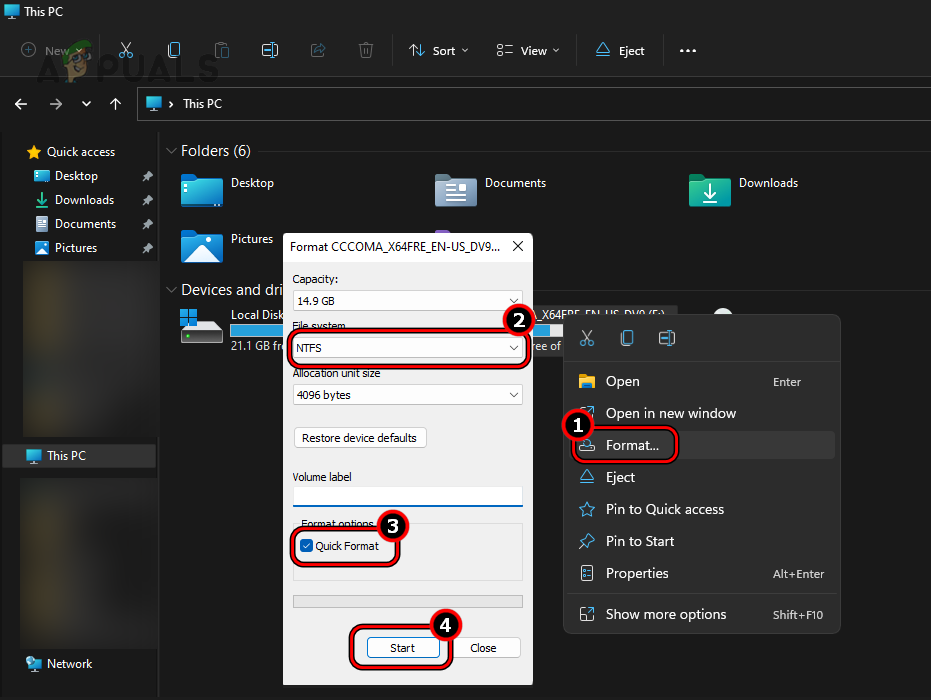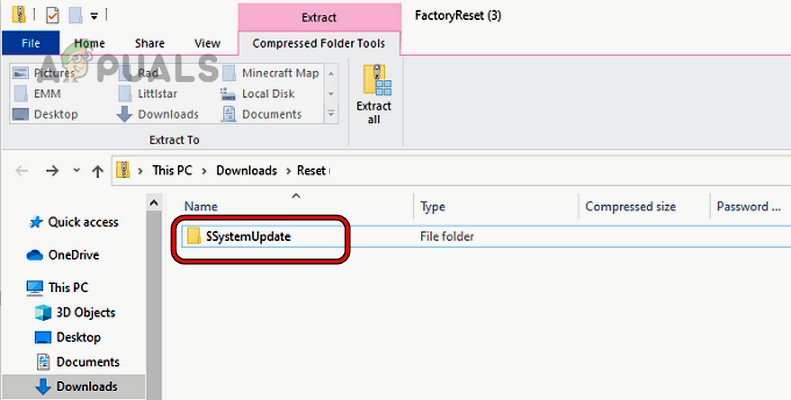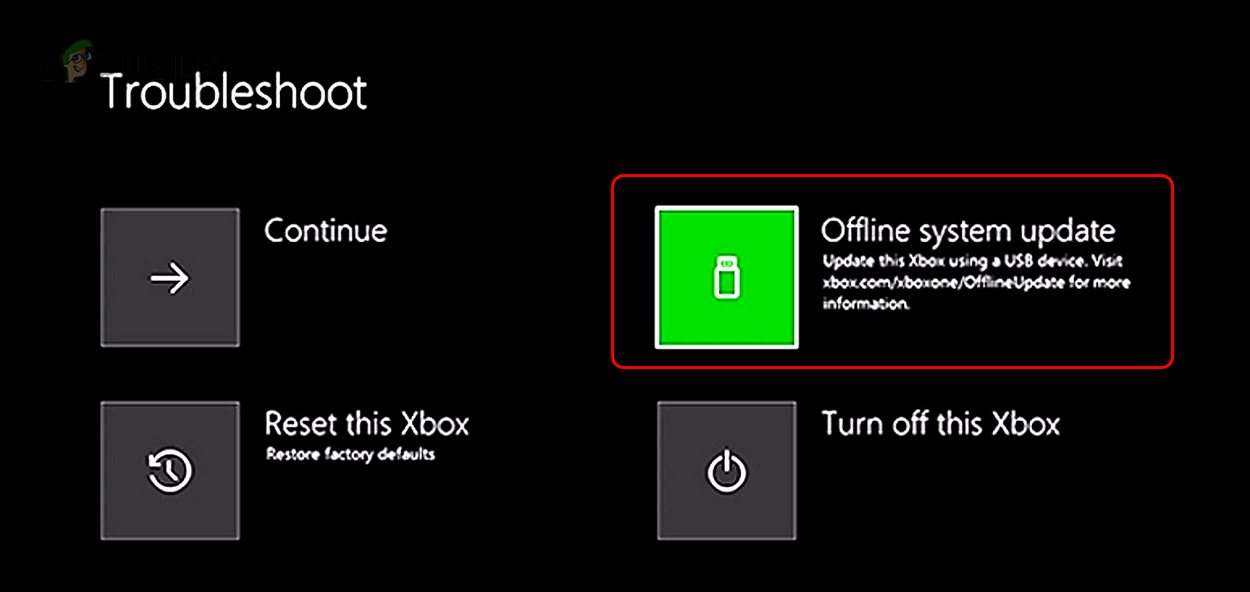How to Perform an Offline Update on a Xbox console?
If you are unable to update your Xbox, encountering the green screen of death, or dealing with network connection issues that prevent updates, you can use the Xbox Offline Update to update your console.

You can download the Xbox OSU (Offline System Update) and place it on a USB drive. Then that drive can be used to install the OSU onto your Xbox.
Prerequisites of Performing an Xbox Offline Update
To perform Xbox offline update, make sure the following conditions are met:
- A Windows PC with a USB port.
- Stable Internet connection.
- A USB Flash Drive with at least 6GB of Space and formatted as NTFS.
- Enough free space is available on the console’s internal hard drive to complete the update process.
- Your Xbox is not enrolled in a preview/insider build or part of the beta program. If it is, unenroll the Xbox from the preview build and perform a factory reset on the console. Afterward, you can try the offline update.
Format the USB Drive in NTFS
- Plug the USB drive into the PC and right-click on Windows.
- Open File Explorer and in the left pane, go to This PC.
- Right-click on the USB drive and select Format.
- Change the dropdown of File System to NTFS and checkmark Quick Format (if unchecked).

Quick Format the USB Drive in NTFS - Click on Start and confirm to format the drive.
- Once done, click on OK and safely eject the USB from the system tray.
- Unplug the USB from the system.
If you fail to format the USB drive, restart the system and try again. Make sure no File Explorer window is opened or the system’s antivirus is not scanning the drive.
Offline Update Process of Xbox Variants
The offline update process on your Xbox depends on its variant. The update process is the same for all Xbox consoles except the original Xbox One.
Update All Xbox Consoles (except the original Xbox One)
Step 1: Download and Extract the OSU1 File
- Launch a web browser on the PC and download the official OSU1 update.
- Wait till the download completes and once downloaded, open the folder where the OSU1 file was downloaded.
- Right-click on the OSU1 file and select Extract All. Wait till the extraction completes.
Step 2: Copy the Extracted Update File to the USB Drive
- Plug the USB drive into the PC and copy the $SystemUpdate (from the extracted OSU1 file) folder to the root directory of the USB.

Copy the SystemUpdate Folder to the Root Directory of the USB - Once copied, unplug the USB drive from the PC.
Step 3: Update the Xbox Console
- Power off your Xbox and unplug it from the power source.
- Wait for a minute and plug back the console into the power source.
- Press and hold the following buttons:
Pair (located on the Xbox’s left side) Eject (located on the Xbox’s front)
- Press the Xbox button on the console and keep on holding the other two buttons until the second power-up tone is heard. This may take around 10 to 15 seconds. If your Xbox does not have an Eject button (such as Xbox Series S or Xbox One S All-Digital Edition), complete the above steps only using the Pair button.
- Release the buttons on the second power tone and you will be taken to the Xbox Startup Troubleshoot screen.
- Plug the USB drive into the Xbox console and the Offline System Update option will become active.
- Use the D-pad to go to Offline System Update and press the A button to initiate the update process.

Select Offline System Update in the Xbox Troubleshoot Menu - Wait till the process completes and once done, you will be taken to the Home screen of the console.
Keep in mind that the Xbox may take a long time to restart after the update process completes and you may need to connect the console to the Internet at least once during the setup process.
Update Original Xbox One
Step 1: Try the Xbox Startup Troubleshoot
- In the above-discussed Step 3 (Update the Xbox Console), follow from 1 to 5 and check if the Startup Troubleshoot screen is shown. If so, then use the above-discussed method (Update All Xbox Consoles (except the original Xbox One)) to update the Xbox One console.
Step 2: Check the OS Version of the Xbox
If the Xbox Startup Troubleshooter is not shown, then follow the steps below:
- Open the Xbox guide and navigate to Profile & System> Settings > System.
- Open Console Info and note down the OS version of your Xbox. This will help us in downloading the required update file.

Check the OS Version of the Xbox
If the Xbox OS version is any of the following 11, you need to perform a single update (OSU1) discussed in step 5:
- 2.11791.0 (xb_rel_1411.141114-2300) fre
- 2.12521.0 (xb_rel_1503.150305-1449) fre
- 2.12998.0 (xb_rel_1506.150601-2200) fre
- 2.13326.0 (xb_rel_1508.150810-2029) fre
- 2.13332.0 (xb_rel_1508.150903-2141) fre
- 0.10586.1006 (th2_xbox_rel_1510.151107-2322) fre
- 0.10586.1016 (th2_xbox_rel_1510.151118-2147) fre
- 0.10586.1024 (th2_xbox_rel_1510.151203-1909) fre
- 0.10586.1026 (th2_xbox_rel_1510.151217-1035) fre
- 0.10586.1100 (th2_xbox_rel_1602.160210-2122) fre
- 0.10586.1194 (th2_xbox_rel_1603.160317-1900) fre
For all other versions, you will need to perform two updates (OSU2 or OSU3 and OSU1).
Step 3: Download the Update File (OSU2 or OSU3)
- For 6.2.9781.0, download the official OSU3 update file. For all other OS versions, download the official OSU2 update file.
- Right-click on the downloaded update file and select Extract All.
- Plug the USB into the PC and copy the extracted folder ($SystemUpdate) to the root directory of the USB drive.
- Unplug the USB from your PC.
Step 4: Update Your Console
- Plug the USB drive into the console and power off the console.
- Unplug the console from the power source and wait for 30 seconds.
- Plug back the console into the power source and press/hold the following buttons:
Pair Eject
- Press the Xbox button and keep on holding the other two buttons.
- Release the buttons when you heard the power tone for the second time. This may take around 10 to 15 seconds. The first tone is the indication that an update file is detected while the second tone indicates that the file is copied and mounted.
- Once the console boots, the first update is complete.
The console may take a long time to restart and you may need to connect the console to the Internet (at least once) during the system setup process.
Step 5: Download the OSU1 File
If your console requires only one update, you will need to use the OSU1 file. If you have used OSU2 or OSU3 update, then OSU1 update is also required.
- Launch a web browser and download the OSU1 file from the official source.
- Right-click on it and select Extract All.
- Plug the USB drive into the PC and if OSU2 or OSU3 files are present on the drive, delete those files.
- Copy the extracted OSU1 file ($SystemUpdate) to the root directory of the USB drive and unplug the USB from the PC.
Step 6: Update Your Console
- Plug the USB drive into the console and power off the Xbox.
- Unplug the power cable of the console and wait for 30 seconds.
- Plug back the power cable of the console and press/hold the following buttons:
Pair Eject
- Press the Xbox button and release the other two buttons when you hear the power-up tone for the second time.
- Once the Xbox reboots, the update process would be complete.
The console may take a longer time to restart and you will need to connect the Xbox to the Internet during the system setup process.
If the Update Fails with Something Went Wrong Screen
- Restart the console from the Xbox Startup Troubleshoot screen and if the Home screen is shown, the console has been updated.
- Reset the Xbox while keeping apps and games from the Xbox Startup Troubleshoot. If the Home screen is shown on the screen, the console has updated and no further action is required.
- Use the Xbox Startup Troubleshoot screen to Restore the Xbox to the factory defaults and the Home screen is shown, offline update is successful and no further action is required.
If Update Fails with Other Errors
- Power off the console by pressing and holding the Xbox button on the console for 10 seconds. Again, press the Xbox button to turn on the console. If the Home screen is shown, the update was successful.
- Repeat steps 1 to 5 in Step 3 (Update the Xbox Console) to boot the console into the Xbox Startup Troubleshoot. Select Reset This Xbox while Keeping Games and Apps. Once done and the Home screen is shown, the offline update is successful and no further action is required.
- Repeat steps 1 to 5 in Step 3 (Update the Xbox Console) to boot the console into the Xbox Startup Troubleshoot. Select Reset This Xbox and click on Remove Everything. Once done and the Home screen is shown, the offline update is successful and no further action is required.
If you face an E101 00000507 8B05008E error while offline updating on an Original Xbox One, the OSU1 update is not compatible with your Xbox and you will need to use OSU2 or OSU3 after checking the OS version of your Xbox.
If none of the above works, replace the hard drive in your console and retry the update. Otherwise, contact Sony Support.
 Reviewed by
Reviewed by 




